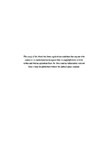An Earthly Response to Movement. Moving Images Diffracted Through New Materialism
| dc.contributor.supervisor | Lewin, Anya | |
| dc.contributor.author | Chapela Pérez, Emilio | |
| dc.contributor.other | School of Art, Design and Architecture | en_US |
| dc.date.accessioned | 2022-09-26T10:36:42Z | |
| dc.date.available | 2022-09-26T10:36:42Z | |
| dc.date.issued | 2022 | |
| dc.identifier | 10569691 | en_US |
| dc.identifier.uri | http://hdl.handle.net/10026.1/19637 | |
| dc.description.abstract |
This practice-led research follows my exploration of the Sierra Negra astronomical observatories in Mexico, as well as other sites and temporalities where my practice has drifted: it flows from the heights of two volcanos, across Idaho during a total eclipse of the sun, and into the waters of the Usumacinta River. It proposes an ‘earthly’ (Latour 2016) moving image practice that considers the planet as a source of movement, effects and, affects: a vibrant entity that is not seen as static or mechanical, but one that ‘is moved’ (Serres 1995) because it is agitated by the liveness of matter and by the impact of our anthropocentric endeavours. How can a moving image practice be developed (or reworked) in response to the Earth’s various movements and temporalities, whether atmospheric, geological, astronomical, climatologic or agential? Consequently, how can this practice be put in motion in attunement with these various movements, even when they become turbulent, unstable, precarious, or extremely slow? I explore these questions by appealing to New materialist philosophy associated with Karen Barad (2007), which is a theoretical framework in which entities are not seen as being determined before the interactions: their qualities, capacities, and boundaries emerge from the interplay with matter within a phenomenon. New materialism is “fascinated by affect, force, and movement as it travels in all directions” (Dolphijn and Tuin, 2016, p. 113). It is within this context that I subscribe to what Barad describes as response-ability (2015), a form of engagement that entails a capacity to respond by being accountable in relation to other entities, matter, and movements. I work with the notion of diffraction, a methodological approach for “reading insights through one another in attending to and responding to the details and specificities of relations of difference” (2007, p. 30). Accordingly, I employ diffraction as a means to read ‘moving images’ and ‘New materialism’ through one another to find out what emerges from such an encounter; and to explore if this strategy facilitates less anthropocentric relations with humans and nonhumans alike. The practice that emerges from this research is concerned with a material vitalism (Bennett, 2010) that considers matter as enthusiastic: I refer to clouds, fog, rocks, rivers, and light; but also, and in agreement with filmmaker Elke Marhöfer (2015), to the camera and other apparatuses of the moving image. This form of materialism challenges the predetermined inherited Cartesian categories that relate to the moving image when presented in the form of subjects, objects, and cameras; human and nonhumans; time and space; fast and slow. The various video works submitted for this doctoral project are in dialogue with the writing component. Together, they tell the story of a research committed to movement and flow; a process in that dialogue with what Isabelle Stengers calls ‘Ecology of Practices’ (2013), which are non-neutral tools for thinking and practice that are inseparable from the problem they aim to explore: this entails openness, change, and transformation through time. | en_US |
| dc.language.iso | en | |
| dc.publisher | University of Plymouth | |
| dc.rights | Attribution-NonCommercial 3.0 United States | * |
| dc.rights.uri | http://creativecommons.org/licenses/by-nc/3.0/us/ | * |
| dc.subject | New Materialism Moving Images | en_US |
| dc.subject | Earthly practices | |
| dc.subject | Diffraction | |
| dc.subject | Artistic Research | |
| dc.subject | Astronomy | |
| dc.subject | Art | |
| dc.subject | Filmmaking | |
| dc.subject | Art and Sciences | |
| dc.subject | Relational Ecologies | |
| dc.subject | Usumacinta River | |
| dc.subject | Sierra Negra Observatories | |
| dc.subject | Mexico | |
| dc.subject | Large Millimeter Telescope | |
| dc.subject | Telescope, Large Millimeter | |
| dc.subject | Laboratorio Arte Alameda | |
| dc.subject | Bodies of Water | |
| dc.subject.classification | PhD | en_US |
| dc.title | An Earthly Response to Movement. Moving Images Diffracted Through New Materialism | en_US |
| dc.type | Thesis | |
| plymouth.version | publishable | en_US |
| dc.identifier.doi | http://dx.doi.org/10.24382/643 | |
| dc.identifier.doi | http://dx.doi.org/10.24382/643 | |
| dc.rights.embargoperiod | No embargo | en_US |
| dc.type.qualification | Doctorate | en_US |
| rioxxterms.version | NA | |
| plymouth.orcid.id | https://orcid.org/0000-0002-2403-7014 | en_US |
Files in this item
This item appears in the following Collection(s)
-
01 Research Theses Main Collection
Research Theses Main



